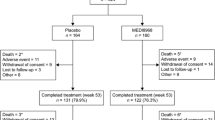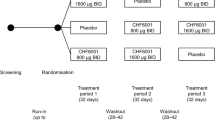Abstract
Introduction
Interleukin-1 beta (IL-1β) and tumor necrosis factor alpha (TNFα) are potentially important in Chronic Obstructive Pulmonary Disease (COPD), but little is known of the relationships between these cytokines and their antagonists in disease compared with healthy controls. It is unclear if concentrations relate to disease severity. The study aimed to investigate these relationships and to assess the potential activity of each cytokine in the context of their antagonists.
Methods
Plasma cytokines, soluble receptors, and cell counts were measured in patients with stable COPD and age-matched healthy controls (n = 15 for both) daily for 5 days; these mediators were also measured in corresponding sputum samples from the COPD patients.
Results
COPD patients had significantly reduced concentrations of the antagonists, IL-1sRII, and IL-1RA compared with controls. In COPD, IL-1β exceeded its antagonists and correlated significantly with BMI and FEV1, while plasma IL-1RA correlated positively with BMI but negatively with sputum IL-1β, neutrophil, and macrophage counts and smoking history. TNFα antagonists exceeded agonists in both groups and did not correlate with COPD severity.
Conclusions
Endogenous IL-1β antagonists appear reduced in COPD. Furthermore, IL-1β correlated with clinical aspects of disease severity, suggesting that IL-1β may play a critical role in COPD. Given the relevant concentrations and binding affinities, it is likely that TNFα has limited activity in stable COPD.


Similar content being viewed by others
References
Aaron SD, Angel JB, Lunau M, Wright K, Fex C, Le Saux N, Dales RE. Granulocyte inflammatory markers and airway infection during acute exacerbation of chronic obstructive pulmonary disease. Am J Respir Crit Care Med 2001;163:349–55.
Chung KF. Cytokines in chronic obstructive pulmonary disease. Eur Respir J 2001;34:50s–9s. doi:10.1183/09031936.01.00229701.
Sapey E, Bayley DL, Ahmad A, Newbold P, Snell N, Stockley RA. Inter-relationships between inflammatory markers in stable COPD patients with bronchitis: the intra and inter patient variability. Thorax 2008;63:493–9. doi:10.1136/thx.2007.086751.
Churg A, Wang RD, Tai H, Wang X, Xie C, Wright JL. Tumour necrosis factor alpha drives 70% of cigarette smoke-induced emphysema in the mouse. Am J Respir Crit Care Med 2004;170:492–8. doi:10.1164/rccm.200404-511OC.
Lucey EC, Keane J, Kuang PP, Snider GL, Goldstein RH. Severity of elastase-induced emphysema is decreased in TNFα and IL-1ß receptor deficient mice. Lab Invest 2002;82:79–85.
Lappalainen U, Whitsett JA, Wert SE, Tichelaar JW, Bry K. Interleukin-1beta causes pulmonary inflammation, emyphysema and airway remodelling in the adult murine lung. Am J Respir Cell Mol Biol 2005;32:311–8. doi:10.1165/rcmb.2004-0309OC.
Oudijk EJ, Nijhuis EH, Zwank MD, van d Graaf EA, Mager HJ, Coffer JW, Lammers JWJ, Koenderman L. Systemic inflammation in COPD visualised by gene profiling in peripheral blood neutrophils. Thorax 2005;60:538–44. doi:10.1136/thx.2004.034009.
Pitsiou G, Kyriazis G, Hatzizisi O, Argyropoulou P, Mavrofridis E. Tumour necrosis factor alpha serum levels, weight loss and tissue oxygenation in chronic obstructive pulmonary disease. Respir Med 2002;96:594–8. doi:10.1053/rmed.2002.1322.
Eid AA, Ionescu AA, Nixon LS, Lewis-Jenkins V, Matthews SB, Griffiths TL, Shale DL. Inflammatory response and body composition in chronic obstructive pulmonary disease. Am J Respir Crit Care Med 2001;15(164):1414–8.
Sevenoaks MJ, Stockley RA. Chronic Obstructive pulmonary disease, inflammation and co-morbidity—a common inflammatory phenotype? Respir Res 2006;7:70. doi:10.1186/1465-9921-7-70.
Pauwels RA, Buist AS, Calverley PM, Jenkins CR, Hurd SS, GOLD Scientific Committee. Global strategy for the diagnosis, management and prevention of Chronic Obstructive Pulmonary Disease. NHLBI/WHO Global Initiative for Chronic Obstructive Lung Disease (GOLD) Workshop summary. Am J Respir Crit Care Med 2001;163:1256–76.
Woolhouse IS, Hill SL, Stockley RA. Symptom resolution assessed using a patient directed diary card during treatment of acute exacerbations of chronic bronchitis. Thorax 2001;56:947–53. doi:10.1136/thorax.56.12.947.
Mikami M, Llewellyn-Jones CG, Bayley D, Stockley RA. The chemotactic activity of sputum from patients with bronchiectasis. Am J Respir Crit Care Med 1998;157:723–8.
Woolhouse IS, Bayley DL, Stockley RA. Effect of sputum processing with dithiothreitol on the detection of inflammatory mediators in chronic bronchitis and bronchiectasis. Thorax 2002;57:667–71. doi:10.1136/thorax.57.8.667.
Stockley RA, Bayley DL. Validation of assays for inflammatory mediators in sputum. Eur Respir J 2000;15:778–81. doi:10.1034/j.1399-3003.2000.15d24.x.
Sankoh AJ, Hugue MF, Dubey SD. Some comments on frequently used multiple endpoint adjustment methods in clinical trials. Stat Med 1997;16:2529–42. doi:10.1002/(SICI)1097-0258(19971130)16:22<2529::AID-SIM692>3.0.CO;2-J.
Anthonisen NR, Manfreda J, Warren CP, Hershfield ES, Harding GK, Nelson NA. Antibiotic therapy in exacerbations of chronic obstructive pulmonary disease. Ann Intern Med 1987;106:196–204.
Gamble E, Qiu Y, Wang D, Zhu J, Vignola AM, Kroegel C, Morell F, Hansel TT, Pavord I, Rabe KF, Barnes NC, Jeffrey PK. Variability of bronchial inflammation in chronic obstructive pulmonary disease: implications for study design. Eur Respir J 2006;27:293–9. doi:10.1183/09031936.06.00027705.
Borrill Z, Starkey C, Vestbo J, Singh D. Reproducibility of exhaled breath condensate pH in chronic obstructive pulmonary disease. Eur Respir J 2005;25:269–74. doi:10.1183/09031936.05.00085804.
Cannon JG, Abad LW, Vannier E, Lynch EA. Menstrual and gender dependent variations in circulating IL-1 agonists, antagonists and binding proteins. J Leukoc Biol 1998;63:117–23.
Catania A. Interactions among POMC-derived peptides and cytokines in control of the acute phase response in the aged. Italian National Research Council. http://www.aging.cnr.it/uoe/uo1_048.htm, 2007.
Ludwiczek O, Vannier E, Borggraefe I, Kaser A, Siegmund B, Dinarello CA, Tilg H. Imbalance between interleukin-1 agonists and antagonists: relationship to severity of inflammatory bowel disease. Clin Exp Immunol 2004;138:323–9. doi:10.1111/j.1365-2249.2004.02599.x.
Janson RW, King TE, Hance KR, Arend WP. Enhanced production of IL-1 receptor antagonist by alveolar macrophages from patients with interstitial lung disease. Am Rev Respir Dis 1993;148:495–503.
Osika E, Cavaillon JM, Chadelet K, Boule M, Fitting C, Tournier G, Clement A. Distinct sputum cytokine profiles in cystic fibrosis and other chronic inflammatory airway disease. Eur Respir J 1999;14:339–46. doi:10.1034/j.1399-3003.1999.14b17.x.
Rolfe MW, Standifrod TJ, Kunkel SL, Burdick MD, Gilbert AR, Lynch JP 3rd, Streiter RM. Interleukin-1 receptor antagonist expression in sarcoidosis. Am Rev Dis 1993;148:1378–84.
Rupp J, Kothe H, Mueller A, Maass M, Dalhoff K. Imbalanced secretion of IL-1ß and IL-1RA in Chlamydia pneumoniae infected mononuclear cells from COPD patients. Eur Respir J 2003;22:274–9. doi:10.1183/09031936.03.00007303.
Hirsch E, Irikura VM, Paul SM, Hirsch D. Functions of IL-1RA in gene knock out and over producing mice. Proc Natl Acad Sci U S A 1996;93:11008–13. doi:10.1073/pnas.93.20.11008.
Vecil GG, Larsen PH, Corley SM, Herx LM, Besson A, Goodyer CG, Yong VW. IL-1 is a key regulator of MMP-9 expression in human neurons in culture and following mouse brain trauma in vivo. J Neurosci Res 2000;61:212–24. doi:10.1002/1097-4547(20000715)61:2<212::AID-JNR12>3.0.CO;2-9.
Jain L, Rosenburg GA. Matrix metalloproteinases and free radicals in cerebral ischaemia. Free Radic Biol Med 2005;39(1):71–80. doi:10.1016/j.freeradbiomed.2005.03.033.
Duffield J. The inflammatory macrophage: a story of Jekyll and Mr Hyde. Clin Sci 2003;104:27–38. doi:10.1042/CS20020240.
DosReis GA, Borges VM, Zin WA. The central role of Fas-ligand signaling in inflammatory lung disease. J Cell Mol Med 2004;8(3):285–93. doi:10.1111/j.1582-4934.2004.tb00318.x.
Burger D, Chicheportiche R, Giri J, Dayer JM. The inhibitory effect of human interleukin-1 receptor antagonist is enhanced by type II interleukin-1 receptor and hindered by type 1 interleukin-1 receptor. J Clin Invest 1995;96:38–41. doi:10.1172/JCI118045.
Lennard AC. Interleukin-1 receptor antagonist. Crit Rev Immunol 1995;15:77–105.
Kurrie R, Lauffer L, Roder J, Kanzey EJ, Enssle KH, Seiler FR. Regulation of IL-1 activity by soluble IL-1 receptors. Behring Inst Mitt 1995;96:45–57.
Granowitz EV, Clark BD, Mancilla J, Dinarello CA. Interleukin 1 receptor antagonist competitively inhibits the binding of interleukin-1 to the Interleukin 1 Receptor. J Biol Chem 1991;266:14147–50.
Giri JG, Newton RC, Horuk R. Identification of soluble interleukin 1 binding protein in cell free supernatant. J Biol Chem 1990;265:17416–9.
Dubost JJ, Perrier S, Afane M, Viallard JL, Roux-Lombard P, Baudet-Pommel M, Begue C, Kemeny JL, Sauvezie B. IL-1 receptor antagonist in saliva; characterization in normal saliva and reduced concentration in Sjogren’s Syndrome. Clin Exp Immunol 1996;106:237–42. doi:10.1046/j.1365-2249.1996.d01-824.x.
Sabit R, Bolton CE, Edwards PH, Pettit RJ, Evans WD, McEniery CM, Wilkinson IB, Cockcroft JR, Shale DJ. Arterial stiffness and osteoporosis in chronic obstructive pulmonary disease. Am J Respir Crit Care Med 2007;175:1259–65. doi:10.1164/rccm.200701-067OC.
Grell M, Wajant H, Zimmerman G, Scheurich P. The type 1 receptor is the high affinity receptor for soluble tumour necrosis factor. Proc Natl Acad Sci U S A 1998;95:570–5. doi:10.1073/pnas.95.2.570.
Medvedev AE, Espevik T, Ranges G, Sundan A. Distinct roles of the two Tumour Necrosis Factor (TNF) receptors in modulating TNF and Lymphotoxin α effects. J Biol Chem 1996;271:9778–84. doi:10.1074/jbc.271.16.9778.
Beutler B, Milsark IW, Cerami A. Calchectin/tumour necrosis factor: production, distribution and metabolic fate in vivo. J Immunol 1985;135:3972–7.
Girardin E, Roux-Lombard P, Grau GE, Suter P, Gallati H, Dayer JM. Imbalance between TNFa and soluble TNF receptor concentrations in severe meningococcaemia. The J5 Study Group. Immunology 1994;76:20–3.
Aderka D, Engelmann H, Wallach D. Soluble TNF receptors in health and disease. In: Fiers W, Buurman WA, editors. Tumor Necrosis Factor: Molecular and Cellular Biology and Clinical Relevance. Basel: Karger; 1993. p. 191–8.
Aderka D, Sorkine P, Abu-Abid S, Lev D, Setton A, Cope AP, Walloch D. Shedding kinetics of soluble tumor necrosis factor (TNF) receptors after systemic TNF leaking during isolated limb perfusion relevance to the pathophysiology of septic shock. J Clin Invest 1998;101:50–659. doi:10.1172/JCI694.
Rennard SI, Fogarty C, Kelsen S, Long W, Ramsdell J, Allison J, Mahler D, Saadeh C, Siler T, Snell P, Korenblat P, Smith W, Kaye M, Mandel M, Andrews C, Prabhu R, Donohue JF, Watt R, Lo KH, Schlenker-Herceg R, Barnathan ES, Murray J. The safety and efficacy of infliximab in moderate to severe chronic obstructive pulmonary disease. Am J Respir Crit Care Med 2007;175:926–34. doi:10.1164/rccm.200607-995OC.
Danis VA, Franic GM, Rathjen DA, Laurent RM, Brooks PM. Circulating cytokine levels in patients with Rheumatoid Arthritis: double blind trial with sulphasalazine. Ann Rheum Dis 1992;51:946–50. doi:10.1136/ard.51.8.946.
Hacievliyagil SS, Gunen H, Mutlu LC, Karabuluet AB, Temel I. Association between cytokines in induced sputum and severity of chronic obstructive pulmonary disease. Respir Med 2006;100:846–54. doi:10.1016/j.rmed.2005.08.022.
de Godoy I, Donahoe M, Calhoun WJ, Mancino J, Rogers RM. Elevated TNFα production by peripheral monocytes of weight losing COPD patients. Am J Respir Crit Care Med 1996;153:633–7.
Dal Negro RW, Micheletto C, Tognella S, Visconti M, Guerriero M, Sandri MF. A two stage logistic model based on the measurement of pro-inflammatory cytokines in bronchial secretions for assessing bacterial, viral and non-infectious origin of COPD exacerbations. COPD 2005;2:7–16. doi:10.1081/COPD-200050680.
Gingo MR, Silveira LJ, Miller YE, Friedlander AL, Cosgrove GP, Chan ED, Maier LA, Bowler RP. Tumour necrosis factor polymorphisms are associated with COPD. Eur Respir J 2008;31:1005–12. doi:10.1183/09031936.00100307.
Wood AM, Simmonds MJ, Bayley DL, Newby PR, Gough SC, Stockley RA. The TNF alpha gene relates to clinical phenotype in alpha-1-antitrypsin deficiency. Respir Res 2008;9:52. doi:10.1186/1465-9921-9-52.
Gompertz S, Hill AT, Bayley DL, Stockley RA. Effect of expectoration on inflammation in induced sputum in alpha-1-antitrypsin deficiency. Respir Med 2006;100:1094–9. doi:10.1016/j.rmed.2005.09.024.
Celli BR, Cote CG, Marin JM, Cassanova C, Montes de Oca M, Mendez RP, Pinto Plata V, Cabral HJ. The body mass index, airflow obstruction, dyspnea, and exercise capacity index in chronic obstructive pulmonary disease. N Engl J Med 2004;350:1005–12. doi:10.1056/NEJMoa021322.
Vestbo J, Prescott E, Lange P. Association of chronic mucus hypersecretion with FEV1 decline and chronic obstructive pulmonary disease morbidity. Copenhagen City Heart Study Group. Am J Respir Crit Care Med 1996;153:1530–5.
Prescott E, Lange P, Vestbo J. Chronic mucus hypersecretion in COPD and death from pulmonary infection. Eur Respir J 1995;8:1333–8. doi:10.1183/09031936.95.08081333.
Gamble E, Grootendorst DC, Hattotuwa K, O’Shaughnessy T, Ram FS, Qiu Y, Zhu J, Vignola AM, Kroegal C, Morell F, Pavord ID, Rabe KF, Jeffery PK, Barnes NC. Airway mucosal inflammation in COPD is similar in smokers and ex-smokers; a pooled analysis. Eur Respir J 2007;30:467–71. doi:10.1183/09031936.00013006.
Acknowledgements
We wish to thank Diane Griffiths for her help with patient recruitment during this study and AstraZeneca for unrestricted funding for the study. The salary of E Sapey was supported by the West Midlands Chest Fund.
Author information
Authors and Affiliations
Corresponding author
Rights and permissions
About this article
Cite this article
Sapey, E., Ahmad, A., Bayley, D. et al. Imbalances Between Interleukin-1 and Tumor Necrosis Factor Agonists and Antagonists in Stable COPD. J Clin Immunol 29, 508–516 (2009). https://doi.org/10.1007/s10875-009-9286-8
Received:
Accepted:
Published:
Issue Date:
DOI: https://doi.org/10.1007/s10875-009-9286-8




